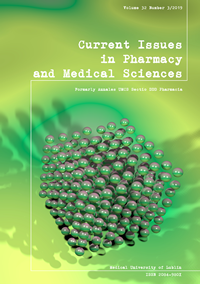Cytoreductive surgery and HIPEC (hyperthermic intraperitoneal chemotherapy) in combined treatment of ovarian cancer: time for the beginning of personalized therapy?
DOI:
https://doi.org/10.2478/cipms-2019-0028Keywords:
ovarian cancer, peritoneal carcinomatosis, cytoreductive surgery, hyperthermic intraperitoneal chemotherapy, p53, BRCA 1Abstract
Background and objectives. During the two past decades, a new therapeutic approach to ovarian cancer (OC) has been developed. This combines cytoreductive surgery (CRS) and hyperthermic intraperitoneal chemotherapy (HIPEC). However, almost no data exist regarding the utility of biomarkers of morphological heterogeneity as prognostic factors in such patients.
Methods. A retrospective study of the effectiveness of CRS and HIPEC was carried out in 59 patients with ovarian cancer. Biomarkers of morphological heterogeneity of OC were studied as prognostic factors: OC pathogenic types (based on the identification of р53 mutated gene protein expression) and homologous recombination deficit (basing on the identification of BRCA 1 gene expression status).
Results. The survival of patients reliably differed with the division into two pathogenetic OC types established by immunohistochemistry: the median disease-free survival of type I OC patients was 14±1.7 months, type ІІ – 8±1.6 months (р = 0.007); the median overall survival of type I OC patients was 23.5±6.7 months, type ІІ – 12±1.9 months (р = 0.017). The median overall survival of patients with the somatic mutation of BRCA 1 gene and complete cytoreduction was 22±4.8 months, and without the somatic mutation of BRCA 1 gene – 12±3.3 months (р = 0.047).
Conclusions. These data demonstrate that identification of the pathogenetic type of OC and BRCA 1 status may be useful for the personalized therapy of ovarian cancer patients treated with CRS/HIPEC.
References
1. Reid BM, Permuth JB, Sellers TA. Epidemiology of ovarian cancer: a review. Cancer Biol Med. 2017;14(1):9-32.
2. Sticca RP, Dach BW. Rationale for hyperthermia with intraoperative intraperitoneal chemotherapy agents. Surg Oncol Clin N Am. 2003;12: 689-701.
3. Elias D, Lefevre JH, Chevalier J, et al. Сomplete cytoreductive surgery plus intraperitoneal chemohyperthermia with oxaliplatin for peritoneal carcinomatosis of colorectal origin. J Clin Oncol. 2009;27:681-5.
4. Moran B, Baratti D, Yan TD, et al. Consensus statement on the loco-regional treatment of appendiceal mucinous neoplasms with peritoneal dissemination (pseudomyxoma peritonei). J Surg Oncol. 2008;98:277-82.
5. Helm JH, Miura JT, Glenn JA, et al. Cytoreductive Surgery and Hyperthermic Intraperitoneal Chemotherapy for Malignant Peritoneal Mesothelioma: A Systematic Review and Meta-Analysis. Ann Surg Oncol. 2015;22(5):1686-93.
6. Deraco M, Virzı S, Iusco DR, et al. Secondary cytoreductive surgery and hyperthermic intraperitoneal chemotherapy for recurrent epithelial ovarian cancer: a multi-institutional study. B J O G. 2012;119:800-9.
7. Fagotti A, Costantini В, Petrillo M, et al. Cytoreductive surgery plus HIPEC in platinum-sensitive recurrent ovarian cancer patients: A case–control study on survival in patients with two year follow-up. Gynecol Oncol. 2012;127(3):502-5.
8. Bakrin N, Bereder JM, Decullier E, et al. Peritoneal carcinomatosis treated with cytoreductive surgery and Hyperthermic Intraperitoneal Chemotherapy (HIPEC) for advanced ovarian carcinoma: A French multicentre retrospective cohort study of 566 patients. Eur J Surg Oncol. 2013;39(12):1435-43.
9. van Driel WJ, Lok CA, Verwaal V, Sonke GS. The role of hyperthermic intraperitoneal intraoperative chemotherapy in ovarian cancer. Curr Treat Options Oncol. 2015;16(4):14.
10. Spiliotis J, Halkia E, Lianos E, et al. Cytoreductive surgery and HIPEC in recurrent epithelial ovarian cancer: a prospective randomized phase III study. Ann Surg Oncol. 2015;22(5):1570-5.
11. van Driel WJ, Koole SN, Sikorska K, et. al. Hyperthermic intraperitoneal chemotherapy in ovarian cancer. N Engl J Med. 2018;378:230-240.
12. Sugarbaker PH. Management of peritoneal-surface malignancy: the surgeon’s role. Langenbeck’s Arch Surg. 1999;384(6):576-87.
13. McCluggage WG. Morphological subtypes of ovarian carcinoma: a review with emphasis on new developments and pathogenesis. Pathology. 2011;43:420-32.
14. Bell D, Berchuck A, Birrer M et al. Integrated genomic analyses of ovarian carcinoma. Nature. 2011;474:609-15.
15. Rojas V, Hirshfield KM, Ganesan S, Rodriguez-Rodriguez L. Molecular characterization of epithelial ovarian cancer: implications for diagnosis and treatment. Int J Mol Sci 2016. 17(12):2113.
16. Pan Z, Xie X. BRCA mutations in the manifestation and treatment of ovarian cancer. Oncotarget. 2017;8(57):97657-70.
17. Foulkes WD. BRCA1 and BRCA2: chemosensitivity, treatment outcomes and prognosis. Fam Cancer. 2006;5:135-42.
18. Lesnock JL, Darcy KM, Tian C et al. BRCA1 expression and improved survival in ovarian cancer patients treated with intraperitoneal cisplatin and paclitaxel: a Gynecologic Oncology Group Study. Br J Cancer. 2013;108:1231-7.
Downloads
Published
Issue
Section
License
Copyright (c) 2019 Autors

This work is licensed under a Creative Commons Attribution-NonCommercial-NoDerivatives 3.0 Unported License.


